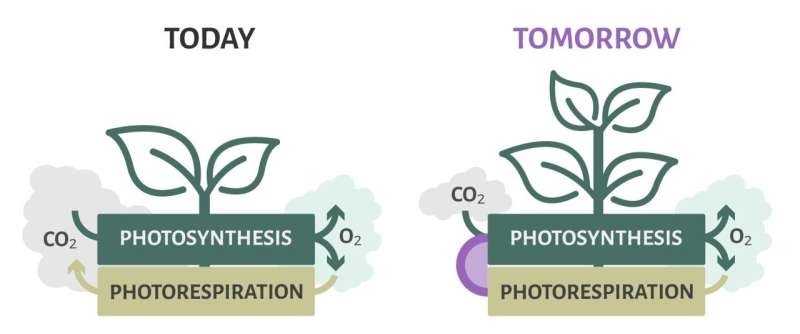Turn problems into opportunities: Photorespiration for improved plant metabolism

In today's plants, photorespiration dissipates some of the energy produced by photosynthesis and releases CO2. It begins when the enzyme RuBisCO acts on oxygen instead of carbon dioxide and creates toxic side-products requiring costly recycling reactions. The detoxification process uses up fixed carbon and wastes energy, thus strongly limiting agricultural productivity.
Scientists generally pursue two approaches to minimizes the deleterious effects of photorespiration: mimic the carbon concentrating mechanism of C4 plants or introduce new metabolic pathways to bypass the photorespiration.
Researchers led by Andreas Weber from Heinrich Heine University Düsseldorf and Tobias Erb from the Max Planck Institute for terrestrial Microbiology have developed a solution that synergistically couples photorespiration and C4 metabolism, connecting two of the main targets in plant metabolism. Within the EU-funded project Gain4Crops (www.gain4crops.eu), they have turned a photorespiration bypass route, the recently discovered BHAC, into a carbon strengthening mechanism in C3 plants. The team has introduced enzymes from the microbial BHAC pathway in a model plant, Arabidopsis thaliana, where they successfully convert a product of photorespiration into the source of a synthetic C4 cycle and without dissipating carbon, nitrogen, or energy.
After a successful plant transformation, gas exchange measurement and metabolites profiling confirmed that the plant conserves nitrogen and accumulates signature C4 metabolites. The Arabidopsis model showed no gain in the amount of CO2 assimilated via photosynthesis at the expense of the CO2 released by photorespiration; but, as the team pointed out, several bottlenecks might be responsible for masking the full potential of the BHAC pathway.
To fully appreciate the gain in carbon fixed and ultimately in yield, the pathway needs to be improved by identified other targets via kinetic and genomic scale metabolic models. Indeed, prototyping in many model organisms, like Arabidopsis, allows identifying shortcomings before moving to a target crop, thus speeding up the development process. For example, the Gain4crops project plans to test the newly discovered pathway in a set of model organisms of increasing cellular and anatomical complexity before moving to its final target: the sunflower.
Overall this study represents the first proof of concept for carbon-concentrating mechanisms in C3 plant that dependent on photorespiration, coupling the solution with the problem, and creating opportunities for improved agricultural productivity in the future. Furthermore, higher photosynthetic crops might become a valuable tool in the face of climate change thanks to their climate resilience and reduced consumption of resources.
Agriculture needs to keep pace with a growing population on a planet in a short supply of resources and with changing environmental conditions. "Improving sustainability is probably the biggest challenge of the 21st century, and, even if there is no single silver bullet, the combination of different solutions might bring an effective improvement," says Andreas Weber. And in the quest for more sustainable agriculture, agriculture that uses less land and resources engineered crops that tackle photorespiration might be part of the solution.
More information: Marc-Sven Roell et al, A synthetic C4 shuttle via the β-hydroxyaspartate cycle in C3 plants, Proceedings of the National Academy of Sciences (2021). DOI: 10.1073/pnas.2022307118
Journal information: Proceedings of the National Academy of Sciences
Provided by INsrl





















